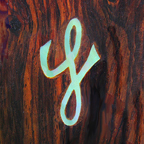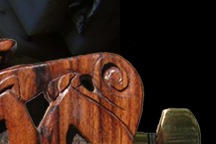        |

|
2023 OPTIONS

Shell Inlay Options:
There are several kinds of shell. Mother-of-pearl is basically white, sometimes pale gold, and is used for well-defined shapes. Abalone (green or red) is more colorful, primarily with pinks and light greens. Paua (pronounced Pow’-uh) has the most dramatic colors, with blues, deep greens, and even some purple. It is best used for purfling lines and linear patterns, because small shapes can be hard to see due to these color variations.
- Edging the soundboard with shell is costly and time-consuming, so add $250. Abalone or paua can be used, depending on personal taste. I have also used gold mother-of-pearl.
- Any number of patterns can be inlaid on the fingerboard. I favor a single unique pattern or shape at the 12th fret (like initials or a Celtic knot), but traditional 3-5-7-9-12-15 fret dots or diamonds are also common. Custom designs like vines or knots are available, price varying with complexity. (Simple side dot fret markers are standard on all guitars.)
- The standard rosette is a 3/16” wide ring of abalone and a slightly larger ring of black-white-black wood.
- Custom rosette designs are also accepted, usually varying from $50 to $100 depending on complexity. I reserve the right to veto a design, or charge more for it, due to the labor-intensive nature of the work.
On the topic of rosettes, a simple wide 5/8” ring of highly figured wood is increasingly popular.
End Panels can either match the sides, or be of a contrasting species. Don’t expect an exact invisible grain-line match even with matching species.
Bindings are the protective edge lines on the body. I use matching fingerboard bindings on request at no additional charge. The choice should be based on the overall design look. Dark sides can have matching dark bindings, with only a thin purfling line to separate the two. This can be understated and elegant. Alternately, curly maple can be a dramatic light contrast. A subtler, warm look can be achieved with a medium-shaded species like cherry or mesquite. Mahogany sides usually call for a dark binding, like Indian rosewood.
Purflings are the thin accent lines that help to set off the bindings. I will choose white (maple) or dark (usually dyed black) or both, depending on what binding and back-and-side wood has been chosen.
Tuners:
- Gotoh 16:1 gold tuners are standard. There is no price break for chrome. Fancy “organic” shape is available. I will use these on request, adding only my additional cost, with no markup on my part. The additional cost for the organic shape is usually around $50. I have been using Gotohs on my personal guitars for 15 years and have no complaints. They are the best value around.
- Schaller is a higher-quality German machine. The gold-plating is thicker and will wear better in the long run. You pay extra for the prestige; they are marginally better machines than Gotoh but they are not a better value for your money. See price list.
- Waverly vintage-look tuners are also available. They are open-backed, potentially allowing debris into the gears. However they are machined to very exact tolerances, much better than the old tuners they emulate, and appeal to those who like a vintage look. See price list.
- Ebony or “pearl” buttons are also available for most brands. Again, I will provide these on request, increasing your price only by my own cost. This is usually a $25 to $50 increase.
Headpiece:
- The standard headpiece has the “swoosh” pattern, also used as the shape of the fingerboard’s end. My script “L” logo is inlaid in the headpiece in mother-of-pearl. (See sample at top left of this page.)
- I currently offer two sculpted head pieces; the Tolkienesque “organic” shape, and the Celtic knot. These require an extra week of work. They’re done entirely with chisels and x-acto blades, plus some emery cloth abrasive. As far as I know, no one else is doing similar work, and they clearly mark your guitar as one of my high-end instruments. For now I am offering these for an additional $250, far below my normal hourly rate. I offer them at this price because in a way they’re a form of marketing, and besides, they’re great fun to execute.
Cutaway:
- A curved Venetian cutaway is available. Tonally a cutaway makes almost no difference, since most of the upper bout is acoustically inactive. Unlike the sculptured headpieces, I don’t find them particularly fun to execute; hence the additional charge (see price list). My suggestion is to forego it unless you truly require access beyond the 14th fret. This will shorten your wait time.
Electronics:
- I offer the L.R.Baggs Active I-Beam pickup (see price list). This is my choice for best reproducing the acoustic qualities of my instruments. It includes a soundhole-mounted volume control, and pre-set equalization that happens to match my guitars quite well. It’s also relatively inexpensive. That’s not why I offer it; it’s just a pleasant coincidence. If you require additional or variable EQ, I recommend you purchase the L.R.Baggs Par-Acoustic DI device that can be worn on your belt.
Neck Options:
- I am no longer offering the laminated five-piece “striped” neck. As with anyone else’s multi-species neck, the different species of wood expand and contract differently with changes in humidity, so tiny but detectable ridges emerge in extreme high or low humidity. There’s no help for it.
- I am now offering an Indian rosewood neck for an additional $50, although there is no additional charge when ordered with exotic hardwoods of $350 or more. Almost all acoustic guitar necks are mahogany, due to its high strength-to-weight ratio. The rosewood neck is equally strong, is visually dramatic (tending to make the design more coherent when paired with dark back-and-sides) but it also adds some weight. Most players can feel the extra weight. Most do not consider this a drawback; some do.
- Frets are now available in a new alloy called EVO. It is harder than standard fretwire, so it won’t wear as quickly, and has a gold sheen rather than silver. The color changes very little as it tarnishes, and it polishes up easily. Different, durable and attractive, I can recommend this as a real value since it will put off the inevitable fret-reconditioning job by years. See price list.

|

|
OPTIONS GALLERY

| Visit the Options Gallery for photos and much more.
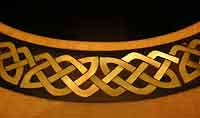
Rosette: Celtic, in gold
mother-of-pearl

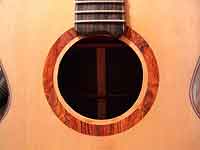
Rosette: Hardwood (unfinished)

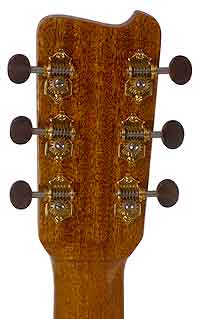
Vintage style Waverly Tuners

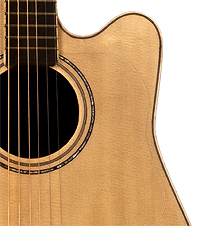
Dreadnaught cutaway
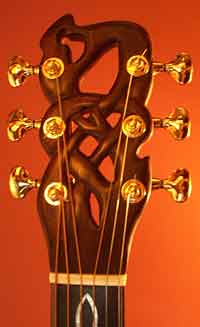
Scupltured Organic Peghead

|
|
